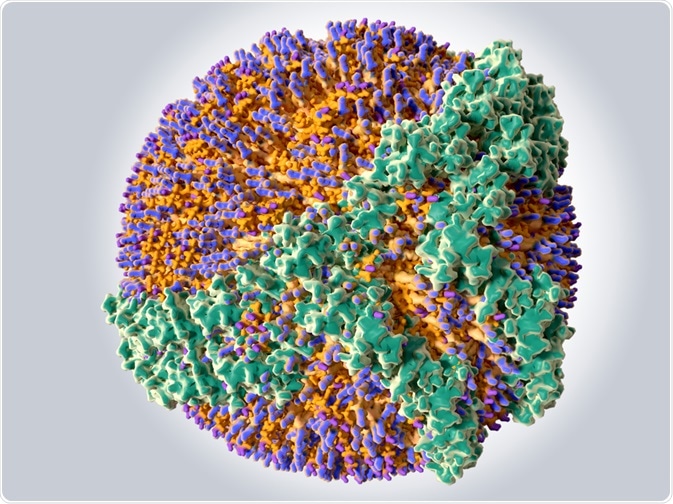Lipoproteins are classified based on their density, electrophoretic mobility, and nature of apoprotein content. Based on their density, lipoproteins can be classified into chylomicrons, very low-density lipoproteins (VLDL), intermediate density lipoproteins (IDL), low-density lipoproteins (LDL), and high-density lipoproteins (HDL).

Juan Gaertner | Shutterstock
Lipoproteins are complex particles that consist of a central core of cholesterol esters and triacylglycerols that are nonpolar in nature. To make lipoproteins hydrophilic, the central core is surrounded by amphipathic molecules such as apolipoproteins, free cholesterol, and phospholipids with the polar groups facing the aqueous medium.
Lipoproteins with a higher fat to protein ratio are larger and less dense. This allows lipoproteins of different sizes to be separated and identified through processes such as electrophoresis and ultracentrifugation. Upon centrifugation, lipoproteins with high protein content sediment easily due to their high density whereas lipoproteins with high lipid content have low density and will float on the surface.
Classifying lipoproteins based on density
High-Density Lipoproteins (HDL)
HDL has a density range between 1.063 and 1.121 g/mL and size between 5 and 12 nm. In a healthy individual, it is composed of approximately 33% protein, 29% phospholipid, and 8% triacylglycerol.
The role of HDL is to collect fat molecules such as phospholipids, cholesterol, and triglycerides in the cells of the body and transport it to the liver to be broken down. HDL is sometimes known as “good” cholesterol because high concentrations of this lipoprotein usually correspond to healthier blood vessels and lower risk of atherosclerosis.
Low-Density Lipoproteins (LDL)
The density of LDL is between 1.019 and 1.063 g/mL and ranges in diameter from 18 to 28 nm. In a healthy individual, it is composed of approximately 25% protein, 21% phospholipid, and 4% triacylglycerol.
LDL is important for the transport of fat molecules such as phospholipids, cholesterol, and triglycerides around the body. It is sometimes known as “bad” cholesterol because elevated concentrations of LDL are an indicator of an underlying disease such as atherosclerosis and other cardiac diseases.
Subtypes of LDL are large buoyant LDL (lb-LDL) and small dense LDL (sd-LDL).
Intermediate Density Lipoproteins (IDL)
The density of IDL is between 1.006 and 1.019 g/mL and ranges in diameter from 25 to 50 nm. In a healthy individual, it is composed of approximately 31% triacylglycerol, 22% phospholipid, and 18% protein. This type of lipoprotein is not usually present in the blood when fasting.
Very Low-Density Lipoproteins (VLDL)
VLDL has a density between 0.950 and 1.006 g/mL and ranges in diameter from 30 to 80 nm. In a healthy individual, it is composed of approximately 50% triacylglycerol, 18% phospholipid, and 10% protein.
This lipoprotein is responsible for the transportation of synthesized triglyceride from the liver to the adipose tissue for storage.
Chylomicrons
The density of chylomicrons is less than 0.95 g/mL and ranges in diameter from 100 to 1000 nm. In a healthy individual, it is composed of approximately 84% triacylglycerol, 7% phospholipid, and less than 2% protein.
These lipoproteins are responsible for the transportation of triglycerides in the gastrointestinal tract to other parts of the body, such as the liver, skeletal tissue, and adipose tissue.
Classification of lipoproteins by electrophoretic mobility
Lipoproteins are also classified by their electrophoretic mobility pattern into alpha (α), beta (β), pre-β, and broad-β lipoproteins. Those lipoproteins with minimum protein content move faster whereas the lipoproteins with higher protein content move slower.
The movement of lipoproteins is based on the nature of the apoprotein associated with the lipoprotein. α lipoproteins have the highest protein content. HDL are α lipoproteins, VDL are pre-β lipoproteins, LDL are β lipoproteins, and IDL are broad-β lipoproteins.
Classification of lipoproteins by apolipoprotein content
Lipoproteins are also classified by the nature of apolipoprotein content. Known as the brain of the lipoprotein system, apolipoproteins regulate many processes of remodeling and uptake. Apolipoproteins bind to the surface of the lipoproteins complex.
With the help of specific enzymes or proteins that the complex binds to on the cell membrane, the lipoproteins are directed to the metabolic site. Apolipoproteins are broadly classified into A, B, C, and E. HDL primarily consists of apolipoprotein A while LDL and VLDL primarily consist of apolipoprotein B.
Chylomicrons consists of a truncated form of apolipoprotein B that is apoB-48. Apolipoprotein C occurs in HDL, VLDL and chylomicrons and apolipoprotein E occurs in all classes of lipoproteins.
Further Reading